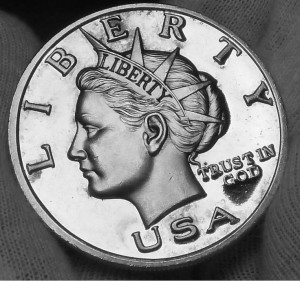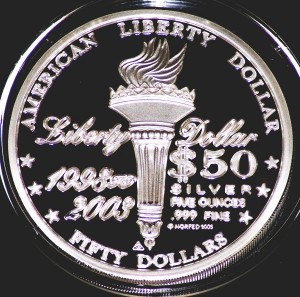Government to Return Most NORFED "Liberty Dollars"
 Source: Pinterest
Source: PinterestIn 2007, the U.S. government confiscated huge quantities of NORFED "dollars," the brainchild of Bernard von NotHaus. These medallions were distributed among like-minded members of the NORFED network. (NORFED stands for National Organization for the Repeal of the Federal Reserve and Internal Revenue Code.) Now that von NotHaus has been sentenced to probation and house arrest, much of the seized assets are set to be returned to the people who bought them.
Although Mr. von NotHaus was indicted in 2009, and was convicted as far back in 2011, the fate of the remaining "Liberty dollars" has been in question ever since. According to filings in federal courts, nearly 90% of the petitions to have the confiscated medals returned have been approved, totaling millions of dollars in gold, silver, and platinum.
What Were NORFED Dollars?
The idea behind NORFED's program was, at its heart, altruistic: dissatisfied with the Federal Reserve system (like many Americans), von NotHaus sold and distributed his medals of gold, silver, copper, and even platinum as a way for Americans to barter and engage in commerce without using U.S. dollars. The Liberty dollars carried symbolic denominations that were explicitly negotiable between parties; the point was to exchange the coin-like metals based on what another party was willing to offer for them. NORFED had the pieces struck by the Sunshine Mint, one of the country's leading private mints, which explains the rather sharp detail and high quality of the Liberty dollars.

The plan began in 1998 and slowly accumulated over time. As the pieces eventually spread and gained more frequent use, the Feds took notice and stepped in under the pretext of anti-counterfeiting. In principle, the NORFED "dollars" were hardly counterfeits, intended not to mimic legal tender or be passed off as such, but as a separate form of currency altogether. In practice, however, the Liberty dollars' use of certain numismatic devices—"TRUST IN GOD" rather than "IN GOD WE TRUST"; depicting the bust of a Lady Liberty figure; the use of the "$" dollar sign to indicate denominations—made it easy enough for the government to argue that they could be misinterpreted by unknowing consumers to be U.S. legal tender.
Now What?
Insofar as the supposedly illicit Liberty dollars functioned as money, they won't be seen very often in barter and trade now that the government has secured a definitive ruling. Yet, even before the announcement that many of the precious metal medallions would be returned to the consumers who rightfully paid for them, there was already a secondary market developing for them. No longer an alternative circulating currency, the pieces clearly hold sentimental and collectible value to go along with their precious metal content, which carries a certain intrinsic value.
Another reason collectors have been drawn to the pieces (besides their precious metal content) has been the variety of designs. Some medals paid homage to the various core beliefs of NORFED, such as Second Amendment rights on the $2 piece. There was also a design endorsing former Congressman Ron Paul for president in 2008 that appeared across the different metallic compositions.
For now, it seems that the NORFED Liberty dollars will live on with exonumia collectors, especially those designs that were produced in limited mintages.

Everett Millman
Everett has been the head content writer and market analyst at Gainesville Coins since 2013. He has a background in History and is deeply interested in how gold and silver have historically fit into the financial system.
In addition to blogging, Everett's work has been featured in Reuters, CNN Business, Bloomberg Radio, TD Ameritrade Network, CoinWeek, and has been referenced by the Washington Post.
